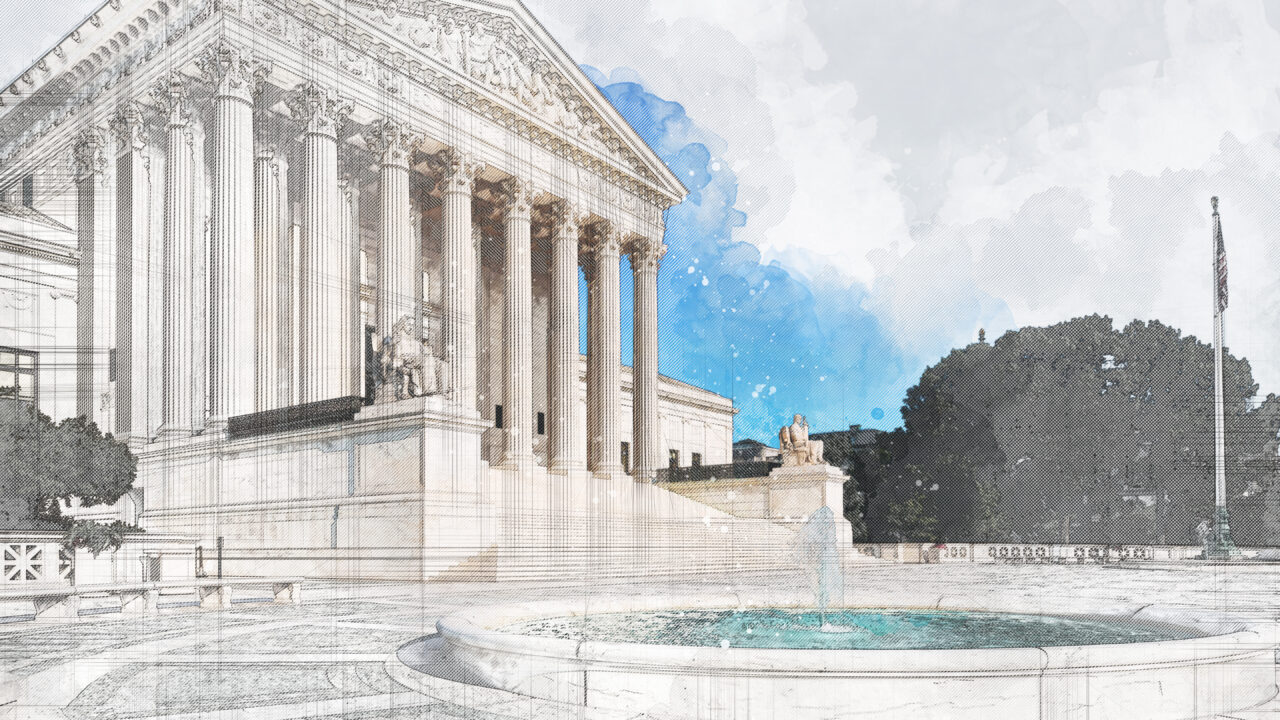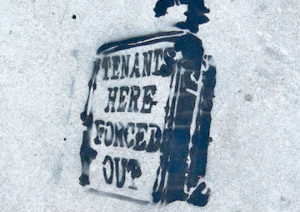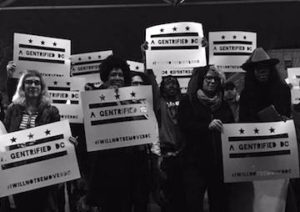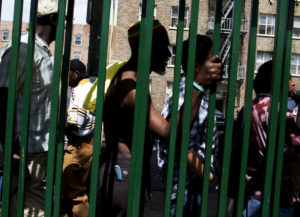Justice from Below
To combat the systemic injustice of our legal system, affirmative organizing needs to begin in the lower courts. Image: Adobe
Image: Adobe
ON A GRAY MORNING at the end of February, I stood outside the Supreme Court with a couple hundred people as the justices heard arguments about the presidential power to offer student debt relief. Bernie Sanders and Elizabeth Warren. Ilhan Omar and Rashida Tlaib. A who’s who of progressives in Congress appeared alongside a coalition of activists, predominantly young and Black. We called on the Court to recognize the legality of the President’s executive order, announced in August 2022, that canceled up to $20,000 of student debt for those making less than $125,000 a year. Some protesters’ demands echoed Joe Biden’s modest cancellation plan. Others, led by Shamell Bell and Maddy Clifford of the insurgent Debt Collective, made clear their vision of cancellation as a window onto a broad decommodification agenda, from the elimination of student, medical, housing, and carceral debt to universal access to all manner of social goods.
I had last attended a protest outside the Supreme Court in 2012. That protest, organized by the Center for Constitutional Rights (CCR), aimed to hold the Obama Administration to its promise to shut down its imperial prison camp at Guantánamo Bay, Cuba. CCR (on whose board I recently served) had led an effort to find legal representation for the almost eight hundred men and boys incarcerated, and to assert the jurisdiction of the federal courts over the offshore detention site. Eleven years later, Guantánamo was still open, and now, rather than asking the Court to act as a shield against executive power, I stood with people asking the Court to lay off. In the gap between these two positions — between calls for SCOTUS intervention and calls for SCOTUS retreat — lies a battle over the courts and even the state in liberal-to-left politics: a shift from litigation-centered strategies to ones based in mobilizing and organizing.
We have just seen the second summer in a row of blockbuster decisions by the Roberts Court that have buoyed the powerful and bludgeoned the dispossessed. In the past year alone, the Court has repealed Roe, gutted affirmative action, struck down student loan forgiveness, and clubbed both workers’ right to strike and the EPA’s power to protect the environment.1 The Court has attacked the livelihoods of ordinary people, consolidating the power of the millionaires and billionaires with whom they make real estate deals and go fishing. Even a casual survey of Court-related headlines — “In Blow to Unions, Supreme Court Rules Company Can Pursue Strike Damage Claim,” ran one NBC headline in June — illustrates the Marxist sociologist Nicos Poulantzas’s insight that the state under capitalism “represents and organizes” the dominant classes while it “disorganiz[es and] divid[es] the dominated classes.”
By and large, the movement strategies are not lawyer- or litigation-led. They do not play by the rules. They are disruptive and tied to affirmative organizing.
The spectacle and substance of this right-wing Court — assembled via the double whammy of the Senate Republicans’ brazen refusal to hold a hearing on Merrick Garland and Trump’s forwarding of three justices during his four years — is straining liberal theories of social change. In the liberal imagination, the legitimacy of the federal courts — from the district trial courts to the circuit courts of appeals to the Supreme Court — has long rested on two ideas: that these courts are neutral forums where judges unspoiled by politics adjudicate conflicts through abstract legal principles; and that they simultaneously work as an essential force in the historical march of progress. Undergirding the first is a commitment to the ideal of the rule of law; underneath the second is the purported dedication of courts to protect “discrete and insular minorities” against majoritarian impulses. 2
This rosy idea of the courts has a long lineage. The role of the federal courts looms large in our anemic social memory of the 20th-century Black freedom struggle; the 1954 Brown v. Board of Education decision is a set piece. A step toward equality was won via desegregation decisions. But these were complicated victories and the products of deep global struggles. The late legal scholar Derrick Bell observed, and legal theorist Mary Dudziak powerfully echoed, that Brown was a cold war case: the US government filed an amicus brief in support of desegregation on the grounds that legal racial discrimination gave the US a bad look in the face of the communists sweeping the third world. Moreover, those legal triumphs were always partial: de jure rights did not provide much of a buffer against de facto conditions of hunger, police power, or the Klan.
Yet it took cataclysmic losses for the baseline failures of the Supreme Court as a neutral forum to become so broadly evident. By the time Amy Coney Barrett — the third of Trump’s appointees — was confirmed, in October 2020, it was clear the federal courts had become less welcoming to the subordinated classes than they had been for decades. Whatever its fundamental flaws, the Court was now a stunning throne for conservatives, Christians, and capital. A wave of interest in court reform took shape: in his first few months in office, Biden appointed a presidential commission of legal experts (mostly law faculty) to study Supreme Court reform, and the commission issued its report evaluating possible reforms the following December. From the left, academics like Keeanga-Yamahtta Taylor, Aziz Rana, Samuel Moyn, Ryan Doerfler, and Niko Bowie argued that the Supreme Court should be diminished in power or abolished altogether. Their arguments rested less on the conservative face of the current Court and more on its undemocratic character: Nine unelected judges with life tenure hold hostage the will of the people as expressed through Congress, the executive branch, and state and municipal government.
In early May 2023, a few months after the Court heard legal challenges to Biden’s student debt cancellation plan, I attended a meeting in DC of academics, lawyers, and Beltway types to discuss Supreme Court reform. (Bowie, Doerfler, and a few other legal academics were there.) The convenor was Molly Coleman with the St. Paul–based People’s Parity Project, an organization advocating for a legal system that puts “people over profits.” The meeting materials cited many of the legislative reforms discussed by the presidential commission: expanding the Court, term limits and ethics reform for the justices, and removing certain types of cases from the Court’s purview altogether.
It doesn’t require a Marxist sensibility to see that any reformist (or nonreformist) agenda faces larger barriers than voter preferences: what we’re up against is the stranglehold of capital on politics, and the weakness and disorganization of working people and left social movements.
Coleman presented Data for Progress polling about voters’ attitudes and understanding of the Supreme Court: More voters than not think the Court has made life worse. Voters are split on whether the Court has too much power. Almost half to two-thirds of those polled supported court reforms, from term limits to court expansion to extending a code of ethics to the high court. I was by turns intrigued and agitated by the polling. It suggested popular discontent with this oligarchic body. That was exciting. Yet as the day wore on, I worried that the focus on polling fueled a common myopia, suggesting the existence of a functioning democratic process whereby the will of the people could straightforwardly express itself through legislative or administrative means. But it doesn’t require a Marxist sensibility to see that any reformist (or nonreformist) agenda faces larger barriers than voter preferences: what we’re up against is the stranglehold of capital on politics, and the weakness and disorganization of working people and left social movements. Focusing on popular opinion to the exclusion of these structural barriers misconstrues the dizzying tasks ahead.
The Supreme Court is a battleground for politics, one where questions of labor power, social reproduction, surplus populations, and the power of capital are being contested every day. And it is an undemocratic institution. But so are Congress, the presidency, and the administrative state. Even if the polling established that overwhelming majorities of the public supported limiting the Supreme Court’s jurisdiction, it is almost impossible to see a legislative pathway for such modest reform, much less anything more radical. At one point during the meeting, a law professor posed a question to the table of people who work with Congress and the Administration: What do we need to get the ear of the popular branches? The rejoinder was as quick as it was revealing: Do you have a yacht?
In the absence of yachts, taking on an institution as powerful as the Supreme Court will require more than popular opinion and presidential commissions. It will require a movement — or a movement of movements. Those movements are already assembling, and their work will take time and extraordinary effort. But the Supreme Court is far from the sole site of struggle. For all its chutzpah, the Court sees a small number of cases every year, each of them scrutinized to the nth degree and lawyered by the most rarefied of lawyers. Meanwhile, thousands of lower courts are performing a parallel function, doing the ground-level work of debt collection, incarceration, and deportation every day. These federal, state, and municipal courts — which employ tens of thousands of judges, lawyers, clerks, guards, janitors, and more — are where some of the most meaningful political conflicts are taking place.
* * *
IF, AS THE POLITICAL SCIENTISTS Joe Soss and Vesla Weaver have written, the police are the face of the state for “race-class subjugated communities” — issuing tickets, citations, and deportation notices — then the United States’ network of state, local, and immigration courts could fairly be characterized as a middle guard. Ostensibly adjudicating the fairness of police action, courts more often rubber-stamp the state power that police exercise. By the time the ink dries, many forces have converged: the courts invoke laws that reflect the domineering if fractured will of the ruling class, who are lent firepower by police, their unions, and more recently police foundations, all of which work, in turn, to sanction violence and exploitation of many stripes.
Lower courts are among the spaces that determine and deflect how class is lived through the modalities of race, gender, immigration status, and disability. As Stuart Hall and his coauthors wrote in Policing the Crisis about Britain in the 1970s,the courts “produce and reproduce the social conditions of the black working class, shape the social universe and the productive world of that class, and assign its members and agents to positions of structured subordination within it.” The brilliance of Policing the Crisis comes from its steady devotion to a time and place. But the truth is that here and now, courts are a terrain of struggle too.
Lower courts are among the spaces that determine and deflect how class is lived through the modalities of race, gender, immigration status, and disability.
Beyond Criminal Courts, an online project launched late last year by the abolitionist groups Community Justice Exchange, Interrupting Criminalization, and Critical Resistance, provides tools to organizers extending their work on the prison industrial complex to encompass criminal courts as central staging grounds for carceral power. The website features a comic aboutEsther, a fictionalized Haitian migrant navigating the legal process in New York City. Her journey illustrates the sorts of encounters millions of Americans have over the course of their lives — encounters with a brutal matrix of judicial power, the state, and capital.
Esther’s first point of contact with the legal system happens at Duane Reade, where a private security guard accuses her of stealing. “I had just lost my job,” Esther explains, and had no money for “rent and endless bills” or “makeup, diapers, and baby formula.” The security guard at Duane Reade calls the NYPD, who arrest Esther; in turn, an assistant prosecutor in Brooklyn charges her with multiple felonies. Esther is in jail for twenty-four hours before going to court, where she is held in another jail inside the courthouse before she sees the judge in handcuffs. The comic doesn’t show this, but it would be yet another armed guard of the state who moves Esther. This expensive and well-staffed brutalization goes on for months, as she is jailed at Rikers and an overworked and underresourced public defender encourages her to take a plea deal to ward off a felony record. Esther is aware, though, that Immigration and Customs Enforcement (ICE) could commence deportation proceedings on the grounds of the criminal conviction at any time. For the next two years, Esther is under various forms of supervision and monitoring, with a curfew and court-ordered counseling sessions. But “the collateral consequences won’t go away.” The misdemeanor conviction “makes finding jobs, securing housing, and accessing public benefits much more difficult.” Meanwhile, the Walgreens Boots Alliance, the Fortune 100 company that owns Duane Reade, reported $35.4 billion in revenue and $118 million in net income as of May 2023 just this year.
Esther’s story illustrates how the courts do not work in isolation: a web of private power (Duane Reade), private security (the guard), and the police ensnares poor and working-class people by legal process. That process has ripple effects for the Esthers of the world as much as it does for the Duane Reades. The same is true outside criminal courts. Immigration courts rely on ICE and its own archipelago of detention facilities and surveillance technologies to incarcerate and deport. Housing courts rely on county sheriffs, and defer to landlords and real estate lawyers, to effectuate evictions and collect rents. Traffic and municipal courts rely on police, jails, and prisons to lock people up for all manner of survival activity. Family courts rely on mandated reporters to monitor parents, who are then investigated by caseworkers (better understood as police) in order to steal children from their parents.
These actors operate interdependently, in concentric relationships. When they conscript you into their orbit, you have no option but to learn to navigate them. Once you’re up against these institutions effectively working together to dispossess, deport, and incarcerate, odds are you will lose, whether or not you have a lawyer of your own. Even in a system like criminal court, where there is a federal constitutional right to counsel, individual defendants cannot outgun the prosecutors who are better compensated, who have more time and resources, and who are upholding laws that were written with the input of prosecutors’ associations, police unions, and real estate industry organizations in the first place. To appreciate the charade, look to the front of the courtroom: it’s the prosecutors and corporate lawyers who are more likely than the opposition to golf with, or become, judges.
Through process, pomp, and circumstance, courts legitimate the violence of police and other on-the-ground agents of exploitation.
The lower courts provide infrastructure to ease the expropriation central to the state under racial capitalism.3 Through process, pomp, and circumstance, courts legitimate the violence of police and other on-the-ground agents of exploitation. The brutality of eviction, incarceration, deportation, and family separation is eased by the rituals of the court — a process that Isaac Balbus, in his 1973 book The Dialectics of Legal Repression, calls “repression by formal rationality.” Examining the role of local courts in responding to the Black revolts that gripped US cities in the 1960s, Balbus argues that the legal system has a flattening effect on social insurgency. Police took rioters off the streets and courts “turn[ed] political conflict into a legal-factual conflict.” By subjecting protesters to bureaucratic procedure, the courts did more than discipline and punish: they “depoliticize[d] collective violence” and “militate[d] against the growth of the consciousness and solidarity of participants.”
We saw the same pattern when police and the military rushed in to crush the 2020 uprisings against Derek Chauvin’s murder of George Floyd. The curfews and the deployment of the National Guard evoked images of tanks across cities on fire in the 1960s. Alongside the spectacle of rubber bullets and gas canisters there were countless arrests. It is hard to get accurate numbers: in the first two weeks of the protests alone, the Associated Press reported over ten thousand arrests; the Washington Post fourteen thousand; and the Hill seventeen thousand. By October, the Associated Press reported that even the feds had arrested more than three hundred people. As in the 1960s, these arrests took people off the streets and slotted them into a tangle of jails and proceduralism — quashing their rebellious hope and creativity into misdemeanor curfew violation or felony looting and arson. And we can see it now in Atlanta, where the state attorney general has levied racketeering charges against sixty-one people organizing against Cop City. Where there is mass organizing, the lethal “legal-factual conflict” that Balbus described is all but guaranteed to follow.
* * *
THE ORDINARY LOWER COURTS are where countless people encounter the law every day. It is precisely because these courts are so ubiquitous — and the processes of dispossession they administer so pervasive — that they have become central places of contestation and organizing against debt, carceral violence, and housing insecurity in recent years. These efforts aim to turn inside out the isolation that legal processes impose on the poor and working class by building solidarity. In her new book Radical Acts of Justice, Jocelyn Simonson writes about some of those organizing efforts, including a constellation of bail funds, cop watchers and court watchers, and participatory defense hubs that have become popular in the past ten years.
There are now roughly a hundred bail funds in the United States, with especially active ones in cities with racial justice movement centers like Atlanta, Chicago, Seattle, and Philadelphia. Bail funds pool collective resources to ward against the jail time that comes with many criminal charges. Through bail funds, community members can join forces to fight the criminalization of those accused of theft, Esthers and forest defenders alike.
Courts are among capital’s many shelters. But if you know where to look, they are a place where capital makes its nature uncharacteristically visible.
Court watches bring people together to sit in local and state courtrooms, observe, and note unjust patterns within legal proceedings. In 2014, the St. Louis–based ArchCity Defenders issued a white paper on the municipal courts based on their extensive court watching program. That report, understood as a precursor to the DOJ’s Ferguson report issued the following year, documented the banal brutality of roughly thirty courts that collected millions in fines and fees from Black, poor, and housing insecure people in St. Louis County. The arrest warrants then issued for failure to pay landed many in jail, rendering them ineligible for the meager housing and public assistance programs available. By the design of municipal officials, judges, and the police, the millions Ferguson generated in fines and fees made up a whopping 20 percent of the local budget, offsetting tax cuts for the wealthy and local corporations.
Simonson writes about Philadelphia Bail Watch, which sends between one and thirty court watchers to many court cases in the city, wearing matching tees that announce their presence: Philadelphia Bail Fund. By visibly sitting in courtrooms where judges, prosecutors, and even defense attorneys tend to operate as if they are in a vacuum, court watchers shift the balance of power in small but significant ways. Fred Ginyard, an organizer with the effort, explained to Simonson that when they watch, bail is set in fewer of the cases than when they don’t.
Participatory defense hubs, meanwhile, connect families and organizers to contest the isolation of criminal prosecution. Simonson writes about an instance in which Community Defense of East Tennessee prevented the imprisonment of a young man who the prosecutor claimed was part of a dangerous gang. That hub put together a “sociobio binder” for the young man, whose own lawyer had advised he would most certainly be facing prison time. The binder included letters of support from friends and community members and a mental health treatment plan, which the judge ultimately adopted as an alternative to incarceration.
As Simonson narrates, these collective defense strategies draw from movement history. The Black Panther Party, for example, famously organized cop watches in Oakland, following police around to make sure that another set of eyes were always on them when they interacted with Black community members. In the 1930s, the Communist Party’s International Labor Defense department created a defense committee for the Scottsboro Boys. Decades later, the National Lawyers Guild created defense committees for those who participated in the 1971 Attica Uprising and the American Indian Movement for its occupation of Wounded Knee in 1973. Even in the early aughts, I remember heeding the call to “pack the court” for defendants who were charged with overtly political crimes in New York City. We showed up in solidarity as a display of collective support for the judges to witness.
But today’s assemblage of efforts strikes me as different.4 Taken together, the protests happening within and against the courts seem connected as strategic flash points, part of a growing struggle over the value of legal process and legal equality for ordinary people — or even a rejection of the rule of law within this bourgeois democracy. There are litigation efforts to find the assignment of bail without consideration for a person’s ability to pay as unconstitutional, and legislative attempts to attach a right to counsel against deportation, eviction, and family separation. Legal aid and legal services workers continue to do the necessary work of shielding their clients from raw exercises of carceral and corporate power. But by and large, the movement strategies vis-à-vis the courts are not lawyer- or litigation-led. They do not play by the rules. They are disruptive and tied to affirmative organizing.
The protests happening within and against the courts seem connected as strategic flash points, part of a growing struggle over the value of legal process and legal equality for ordinary people — or even a rejection of the rule of law within this bourgeois democracy.
Outside of criminal courts, family courts are receiving new activist attention. In her 2022 book Torn Apart, Dorothy Roberts writes about the growing number of parent-led organizations contesting the ways in which America’s child welfare system (Roberts aptly calls it “family policing”) runs through family courts to tear apart poor and working-class Black, Indigenous, and Latino families. There are new organizations like the Parent Legislative Action Network in New York and the Reimagine Child Safety Coalition in the Bay Area pushing to shrink family policing and questioning the complicity of courts therein. Law school clinics are doing “radical early defense” against the investigation of Black mothers for being poor.
In the domain of immigration courts, immigrant justice activists have physically disrupted deportation processes. Amid the last failed effort at so-called comprehensive immigration reform, in early 2013, activists in Hartford attempted to shut down the ICE office and the immigration court where Jose Maria Islas had received a deportation order. That same fall, activists physically blocked buses and the entrance to a federal courthouse in Tucson: the buses were heading toward Operation Streamline, a program of mass criminal prosecution hearings in border state federal courts. These actions were part of the broader Not1More campaign to stop deportations, in which activists chained themselves to one another, literally obstructing the pipeline from detention to deportation.
While these tactics were never huge in number, they represented a radicalization of the immigrant justice sector and signaled a broader shift in attitude against the courts and legalization. Silky Shah, the executive director of Detention Watch Network, told me that these efforts had a dampening impact on “interior enforcement,” immigration policing within the United States. Alongside more confrontational tactics, organizers waged individual defense campaigns and made strategic efforts to provide immigrants with legal representation in bond hearings. Once out of detention, immigrants were placed on a different, much slower docket. Such efforts at providing bond defense have bought people time and some freedom. Attempting to process hundreds of thousands of people each year, immigration courts are so backed up that court dates for those who are not detained are much less aggressive, with months and months between appearances: an incomplete mitigation against an immigration system so oppressive that winning against it is nearly impossible.
* * *
THROUGH THE LOOKING GLASS of commodification lie two of the most powerful contemporary processes of dispossession: eviction and debt collection. Courts have become central fixtures in enshrining both. (The Supreme Court didn’t just overrule the President’s partial debt forgiveness plan in 2023 but also the Centers for Disease Control and Prevention’s eviction moratorium in 2021.) As immigrant justice activists have called attention to the legal system’s murderous complicity in prosecutions, deportations, and family separations, grassroots fights against eviction and debt collection have made visible how courts extend the grip of capital.
Housing courts — many of which were initially born of tenant struggles, as spaces where renters could contest the landlords and their power to impose slum conditions5 — now effectively function as eviction mills. They work on behalf of real estate and in close cooperation with police and sheriffs. The legal scholar Kathryn Sabbeth explains that landlords use the courts in multimodal ways: beyond possession of real property, “landlords initiate eviction proceedings to extract rental payments and fees,” with “large corporate landlords in particular bring[ing] serial eviction actions against the same tenants, over and over, as a model for collecting rent and generating additional fees.” This rent-collecting model is on the rise. While data on evictions is hard to come by given the realities of informal and formal eviction processes, and the sheer number of local courts that effectuate them, the Eviction Lab’s numbers show that in 2018, landlords filed twice as many eviction proceedings as they did in 2000 (1.159 million in 2000; 3.6 million in 2018).
In response to housing insecurity during the pandemic, organizers have followed the lead of immigrant justice activists and physically obstructed housing courts. In August 2020, the Ithaca Tenants Union blocked the driveway of the city court with couches, shopping carts, and other materials, strategically echoing the scene outside a residence whose tenants had been evicted along with their furniture and belongings. The blockade brought the devastation of eviction into the courthouse, puncturing its sanctimony and apparent distance from the people’s struggles that it weighs in on every day.
Housing courts — many of which were initially born of tenant struggles, as spaces where renters could contest the landlords and their power to impose slum conditions — now effectively function as eviction mills.
In 2021, the Kansas City–based housing justice organization KC Tenants won their Zero Eviction January campaign despite the city’s cessation of its pandemic-era eviction moratorium. Organizers threw sand in the gears of the city’s housing court, disrupting every hearing through court blockades and a barrage of phone calls to courtrooms overseeing evictions by teleconference. They even rallied outside the homes of judges, connecting the comfort of the professional-managerial class to the dispossession of poor and working people. After the group made it simply impossible for the housing court to function, the court paused evictions for two weeks.
Housing court is not the only place where debts are collected, and the bad guys aren’t always corporate landlords. Medical debt collection provides a sobering example. A recent report by National Nurses United found that “between 2009 and 2018, Maryland’s hospitals filed 145,746 lawsuits against their patients, seeking to collect $269 million in medical debt.” The median amount of debt sought by these lawsuits was $944. In over three thousand cases, patients declared bankruptcy. In the meantime, those same hospitals, technically nonprofits, earned almost $1 billion in net income in 2018 alone. When I talked to Sparky Abraham, a consumer lawyer with Jubilee Legal and a legal strategist with the Debt Collective, his research on California courts confirmed a similar judicial function: he scraped Ventura County court data and found that about half of the total civil filings in 2019 were smaller dollar debt collection matters. The most common filers on those cases, he explained, are debt collectors like Midland and Portfolio Recovery Associates, followed by Discover, Capital One, and Bank of America. These debt collectors lean on the courts to collect their debts against ordinary people, the vast majority of whom have no lawyer to guide them through an arcane process. I asked Abraham why Maryland’s hospitals would use the courts to collect from their patients. “The short answer is a court judgment lasts a long time and gives them a lot of power, like the power to garnish wages, lien property, and levy bank accounts.”
Against such massive apparatuses of power, reform campaigns and litigation strategies are climbing Mount Everest, even as they function as necessary modes of contestation. But it is also the case that there is no narrow legalism that will win against these structures. They are too big, too vicious, and too entrenched. What we need is organizing.
* * *
IN 1977, THE SOCIOLOGIST Charles Tilly identified the food riot and the tax rebellion as among the quintessential forms of protest and collective action in pre-Revolutionary Burgundy. When I first encountered his observations, I thought of the sit-ins and the freedom rides as defining tactics of the civil rights movement. Those tactics called for desegregation — building on, for, and with victories in the courts that deemed de jure segregation illegal and that relied on litigation as a strategic place to highlight the contradiction between the promise of the United States and its brutal reality.
I wondered about the major forms of protest in our own era, when the rule-of-law wins of the 20th century look fundamentally different on this burning, militarized planet. Six decades since the courts enabled leaps toward legal equality, we are living in a dystopic shadow of those rights. Legally there are forms of equality, and yet practice makes a mockery of it. Racial separation remains a fact of social life.Voting rights have been hacked away by decades of right-wing onslaught and the disenfranchisement fueled by criminalization. The Warren Court’s anointment of the rights revolution in criminal procedure — extending greater rights to those accused of crime throughout the criminal process — was met with an exponential growth of prisons, police, and jails. The criminalization of intimate partner violence has done little to give women more options, and has instead done much to extend the octopus arms of the carceral state. And all the while, capital has whittled down the wages of ordinary people as it has roamed the world for cheaper outlets and consolidated its power over lawmaking, regulation, and the shape of the state.
At such a conjuncture, in which de jure wins have produced new monstrosities, our own quintessential forms of protest might be the strategies and gestures that move ordinary people to disrupt their routines and take action against the ruling class. The riot, the encampment, and the blockade: Occupy, Ferguson, Standing Rock, the Oakland dockworkers, Stop Cop City. Place matters too. It was in unemployment offices, soup kitchens, and flophouses that Communist Party members organized what became the Unemployed Councils of the 1930s. Now, Joshua Clover observes the freeway and port shutdowns as central sites of circulation struggles, indicating how capital is moving and where it is vulnerable.
Six decades since the courts enabled leaps toward legal equality, we are living in a dystopic shadow of those rights.
To that list we might add the courts. Prison abolitionist organizing has clarified that any understanding of “criminal law,” or even the legal system writ large, must start with the arc of the policeman’s baton, the disproportionate budget of the local jail, and the flow of money from the corporation to the university and the police foundation and back. Each of these institutions can be disrupted, and the long relational chains that legal processes depend on offer many nodes of contact. Disruption happens through protest, but also through building relationships, solidarity, and organization.
When I talked last year to Tara Raghuveer, a founding director of KC Tenants, she explained that as a general matter, “the legal system is designed to suppress energy from the streets and bore us to death with its bureaucracy.” The Supreme Court had just ruled on Dobbs, and KC Tenants was not in the business of modest procedural reforms: the organization, she told me, is “part of a long tradition of organizers and movements that have not just questioned but confronted that socially constructed platform of the courts.” But in the context of Kansas City’s evictions, the courts did offer a unique space to connect with people, to meet them where they were. During Zero Eviction January, she explained, “We would meet people walking into court, and we would say, ‘Hi, we are KC Tenants, we stopped your eviction today, please join us.’”
Much like the lunch counter or the city hall voter registration office marked the protest of the mid-twentieth century, the lower courts may ultimately prove a central site of protest in our time. Courts are among capital’s many shelters. But if you know where to look, they are a place where capital makes its nature uncharacteristically visible, and thus, maybe, uncharacteristically vulnerable. Astra Taylor, a cofounder of the Debt Collective, told me the millions of debt collection lawsuits all over the country illustrate how state power backs exploitative contracts at the core of our economy. Because the debt is often owned by anonymous corporations with PO box addresses, the lawsuits gesture at another strategic opening: countless local venues for contestation.
Recently I spoke to Lindsey Muniak, the lead organizer of the Debt Collective’s efforts to organize against medical debt and a founding member of the End Medical Debt Maryland coalition. For the past few years she has been working with growing coalitions in Maryland to fight medical debt, running alongside the efforts of National Nurses United and 1199SEIU to organize nurses and health care workers across the state. She explained that the group had learned hospitals were relying on court data to pursue debt collection lawsuits. But then the list of cases became useful in another way: “It is a list of people to start organizing.”
Footnotes
- These legal programs were limited at their inception. The right to abortion was articulated through individual privacy; it limited state curtailment of that right, but did not guarantee its availability. Affirmative action was the most meager of redistributive policies, focused on higher education opportunities available to a relatively small number of people. Biden’s executive order was means-tested with a limited maximum amount of cancellation — hardly a dent in the $1.7 trillion in student debt that weighs down forty-three million borrowers. Labor law does not simply represent a politics of compromise: it is the law of the boss. The EPA has had minimal power against fossil fuel and the other industrial drivers of air and water pollution. ↩︎
- So goes the famous language of the Supreme Court’s Carolene Products Footnote Four from 1938, when the Court suggested it would give more exacting review to legislation that discriminated against “discrete and insular minorities.” ↩︎
- A growing number of law scholars are attending to the injustices of the lower courts. In a 2022 article in the Columbia Law Review, Tonya Brito, Kathryn Sabbeth, Jessica Steinberg, and Lauren Sudeall describe the collection of “rent debt, child support debt, and mortgage debt” by a sprawling constellation of local and lower courts as “the cornerstone of the civil legal system.” ↩︎
- More than the NAACP’s Legal Defense Fund (LDF) in Brown, they bring to mind Len Holt, the lawyer who worked with the Student Nonviolent Coordinating Committee. As the legal historian Tomiko Brown-Nagin has documented in her powerful book about the Atlanta civil rights movement Courage to Dissent, Holt encouraged ordinary people to file lawsuits pro se (without a lawyer) to challenge segregation, not in the institution-specific way of LDF that would focus on, say, the schools, or the pools, in a particular lawsuit, but simultaneously in a whole slew of local institutions, in what became known as an “omnibus integration” suit. ↩︎
- In Pittsburgh, for example, the housing court was established in 1967 in response to organizing against slum conditions by the grassroots Citizens Against Slum Housing (CASH). CASH complained that the housing codes and their enforcement were inadequate, and called for the creation of a housing court within its reform platform. Here, tenants could enforce the code themselves. The Pittsburgh City Council created its housing court in response to the campaign. The story of New York City’s housing courts, established in 1972, follows a similar trajectory, spawned by tenant organizations, and a range of supporting cast from the New and Old Left. ↩︎
Independent journalism is under threat and overshadowed by heavily funded mainstream media.
You can help level the playing field. Become a member.
Your tax-deductible contribution keeps us digging beneath the headlines to give you thought-provoking, investigative reporting and analysis that unearths what's really happening- without compromise.
Give today to support our courageous, independent journalists.






You need to be a supporter to comment.
There are currently no responses to this article.
Be the first to respond.